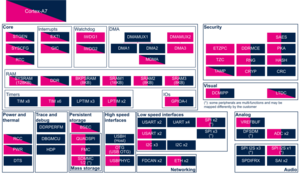Registered User mNo edit summary |
Registered User mNo edit summary |
||
| Line 23: | Line 23: | ||
===Boot time=== | ===Boot time=== | ||
PKA is a boot device, it is used | PKA is a boot device, it is used for signature verification on secure boot processing. | ||
===Runtime=== | ===Runtime=== | ||
Latest revision as of 16:24, 23 September 2022
1. Article purpose
The purpose of this article is to:
- briefly introduce the PKA peripheral and its main features
- indicate the level of security supported by this hardware block
- explain how it can be allocated to the runtime contexts and linked to the corresponding software components
- explain, when necessary, how to configure the PKA peripheral.
2. Peripheral overview
The PKA (public key accelerator) is peripheral is used to ease computation of cryptographic public key primitives, specifically those related to RSA, Diffie-Hellmann or ECC (elliptic curve cryptography) over GF(p) (Galois fields).
2.1. Features
Refer to the STM32MP13 reference manuals for the complete list of features, and to the software components, introduced below, to see which features are implemented.
2.2. Security support
The PKA is a secure peripheral (under ETZPC control).
3. Peripheral usage and associated software
3.1. Boot time
PKA is a boot device, it is used for signature verification on secure boot processing.
3.2. Runtime
3.2.1. Overview
PKA instance is allocated to:
- the Arm® Cortex®-A7 secure core to be controlled in OP-TEE by the PKA OP-TEE driver through the ECC framework.
or
- the Arm® Cortex®-A7 non-secure core to be controlled in Linux® with Linux Crypto framework.
Chapter Peripheral assignment describes which peripheral instance can be assigned to which context.
3.2.2. Software frameworks
| Domain | Peripheral | Software components | Comment | |
|---|---|---|---|---|
| OP-TEE | Linux | |||
| Security | Peripheral (PKA internal peripheral) | OP-TEE PKA driver | Linux Crypto framework | |
3.2.3. Peripheral configuration
The configuration is applied by the firmware running in the context to which the peripheral is assigned. The configuration can be done alone via the STM32CubeMX tool for all internal peripherals, and then manually completed (particularly for external peripherals), according to the information given in the corresponding software framework article.
3.2.4. Peripheral assignment
Click on the right to expand the legend...
| Domain | Peripheral | Runtime allocation | Comment | ||
|---|---|---|---|---|---|
| Instance | Cortex-A7 secure (OP-TEE) |
Cortex-A7 non-secure (Linux) | |||
| Security | PKA | PKA | ☐ | ⬚ | Assignment (single choice) |
4. How to go further
5. References
